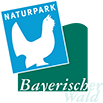Lord of the manor and landscape designer
Beavers on the Arbersee
The beaver has always been an important character in our native fauna. However, hunting from the Middle Ages brought it to the brink of extinction in Germany. The beaver was a sought-after source of meat and fur, and the last beaver in Bavaria was killed in 1867. One hundred years later, a successful reintroduction project was launched, and beavers started returning to the Großer Arbersee only just a few years ago.
To permanently colonise a territory, beavers need a constant water depth of at least one metre. If this is not the case, the animal increases the water depth accordingly by building one or more dams. The lodge is where a beaver family lives, serving as a sleeping chamber, a place to give birth to offspring, and an important venue for social contact with other members of the beaver family. Lodges are always accessed from below the water’s surface. This dome-shaped lodge is built above water level on a bank or from a pile of branches and mud.
The beaver’s profile
Species: Eurasian beaver (Castor fiber)
Appearance: Brown, extremely dense coat (up to 23,000 hairs/cm²); hairless, broad tail (= “trowel”); average weight of around 15 kg, maximum weight up to more than 35 kg
Age: 10 to 15 years in the wild
Habits: Crepuscular and nocturnal; excellent sense of smell and hearing; poor eyesight; does not hibernate
Food: Pure herbivore (summer food: mainly herbs, grasses, leaves and shoots of woody plants; winter food: mainly tree and shrub bark)
Reproduction: Monogamous, permanent mate; mates in winter; 2 to 3 young per year
Protected status: Protected and strictly protected under EU and German law
Initiator of biodiversity
When beavers shape water courses, the habitat for fish, amphibians, dragonflies, birds and aquatic plants improves. A perfect example can be seen here. Turn the disc to see it!
- Creating a beaver dam
When the beaver began to build a dam here on the Geigenbach, the entire forest landscape changed as a result.
- Bark beetle infestation
When the water was dammed, spruces here stood with their “feet” in the water. They became weak, which immediately attracted bark beetles. The beetles flew in and bred beneath the bark.
- Forest dieback
The bark beetle infestation completely killed off the spruce trees, whose needles fell to the ground and bark peeled off. Bats however soon found a perfect daytime roost in the bark pockets.
- More light – more species
Many other species such as butterflies, dragonflies, newts and frogs benefit from this thinning out of the forest stand. Willow, raspberry, blackberry and other flowering plants now flourish in the clearings.
- Initiator of biodiversity
The beaver has created a species-rich biotope here. Beaver habitats are important parts of the biotope system along our water courses. The beaver provides a major, cost-free contribution to boosting biodiversity.
His front teeth (incisors) never stop growing!
Sharpened tree stumps, fresh wood chips and ringed trees are characteristic signs of a beaver at work. He works away, grinding down his ever-growing incisors in the process. What traces of the beaver can you see?
